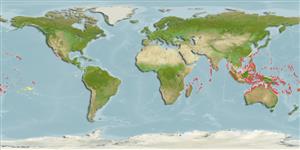Environment: milieu / climate zone / depth range / distribution range
Ecología
marino asociado a arrecife; rango de profundidad 3 - 20 m (Ref. 90102). Tropical; 30°N - 24°S
Indo-Pacific: East Africa to the Marquesan Islands, north to the Ryukyu Islands, south to northern Australia, New Caledonia and Rapa. Throughout Micronesia (Ref. 1602).
Tamaño / Peso / Age
Maturity: Lm ? range ? - ? cm
Max length : 24.0 cm TL macho / no sexado; (Ref. 4201)
Espinas dorsales (total): 11; Radios blandos dorsales (total): 11-13; Espinas anales 4; Radios blandos anales: 7 - 9. Head and body silvery, scales often with blackish spot in centre (Ref. 4201). LL scales with pale red spot and black edges (Ref. 4201).
Found mainly around oceanic islands (Ref. 9710). It is an uncommon inhabitant of reef flats, lagoon and semi-sheltered seaward reefs to depths over 20 m. Occurs with N. sammara in coral-rich areas with large staghorn Acropora corals. Feeds mainly on benthic invertebrates (Ref. 11889).
Life cycle and mating behavior
Madurez | Reproducción | Puesta | Huevos | Fecundidad | Larva
Myers, R.F., 1991. Micronesian reef fishes. Second Ed. Coral Graphics, Barrigada, Guam. 298 p. (Ref. 1602)
IUCN Red List Status (Ref. 130435)
Threat to humans
Harmless
Human uses
Más información
Nombres comunesSinónimosMetabolismoDespredadoresEcotoxicologíaReproducciónMadurezPuestaAgregación para la puestaFecundidadHuevosEgg development
ReferenciasAcuiculturaPerfil de acuiculturaRazasGenéticaElectrophoresesheritabilidadEnfermedadesProcesamientoNutrientsMass conversion
Herramientas
Special reports
Download XML
Fuentes de Internet
Estimates based on models
Preferred temperature (Ref.
123201): 25.2 - 29.3, mean 28.4 °C (based on 2871 cells).
Phylogenetic diversity index (Ref.
82804): PD
50 = 0.5312 [Uniqueness, from 0.5 = low to 2.0 = high].
Bayesian length-weight: a=0.01950 (0.01225 - 0.03104), b=2.95 (2.81 - 3.09), in cm total length, based on LWR estimates for this species & (Sub)family-body (Ref.
93245).
Nivel trófico (Ref.
69278): 4.0 ±0.59 se; based on food items.
Resiliencia (Ref.
120179): Alto, población duplicada en un tiempo mínimo inferior a 15 meses (Preliminary K or Fecundity.).
Fishing Vulnerability (Ref.
59153): Low vulnerability (14 of 100).
Nutrients (Ref.
124155): Calcium = 68.7 [31.1, 214.1] mg/100g; Iron = 0.693 [0.278, 1.457] mg/100g; Protein = 18.8 [17.6, 20.0] %; Omega3 = 0.159 [0.065, 0.380] g/100g; Selenium = 27.1 [15.3, 53.9] μg/100g; VitaminA = 82.9 [30.7, 235.8] μg/100g; Zinc = 1.27 [0.81, 1.98] mg/100g (wet weight);
